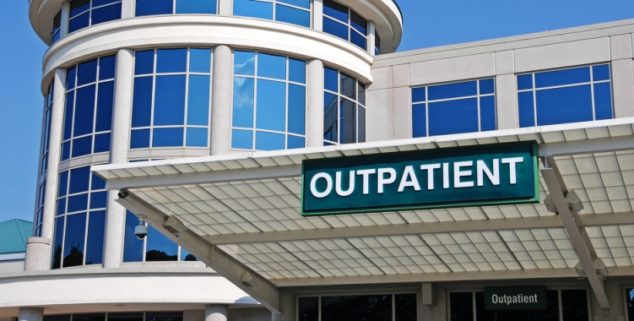Opinion
Improving outpatient care is a necessity
 A hospital's outpatient services unit. (Photo: Mark Winfrey, via Shutterstock)
A hospital's outpatient services unit. (Photo: Mark Winfrey, via Shutterstock)In his state budget proposal, Gov. Gavin Newsom made it clear that health care is a top priority for the Golden State – allocating the largest component of total state-funding to the California Department of Health Care Services (53.5% of the budget, or roughly $34.7 billion).
While he’s only been in office for a short period of time, Gov. Newsom has taken bold steps toward reforming health care business as usual. This includes an executive order directing California state agencies to pursue block negotiation in an effort to pressure pharmaceutical prices downwards. Along with the executive order came a series of health care proposals, including the expansion of Medi-Cal to undocumented individuals and restoring the insurance coverage individual mandate.
Ambulatory surgery centers are outpatient facilities that provide same-day surgeries to patients who are healthy enough to not require an overnight hospital stay post-surgery.
With healthcare costs increasing upwards of seven percent per year, there is mounting pressure on patients, businesses, and employers to absorb these rising costs into their budgets. While the governor’s proposal represents a commitment in California to addressing some of the many nuances that lead to higher health care costs, we must pursue systemic change if we truly want to bend the cost curve.
In the world of health care, we often talk of the “Triple Aim” as the gold standard for optimizing the health system.
This framework, developed by the Institute for Healthcare Improvement, emphasizes a three-part strategy towards a better system of care: 1) improving population health, 2) enhancing patient experience and outcomes, and 3) reducing per capita costs of care. Yet in many cases, advances in one of these areas often comes at the expense of the others.
While the new administration’s efforts are certainly a component of achieving meaningful change, we must complement these efforts by advancing proven healthcare delivery strategies that advance all three goals of the Triple Aim. And this includes expanding patient access to ambulatory surgery centers (ASCs).
ASCs are outpatient facilities that provide same-day surgeries to patients who are healthy enough to not require an overnight hospital stay post-surgery.
ASCs specialize in a specific set of procedures which allows them to tailor their staff, their equipment, and their facilities into an efficient venue for care, eliminating the high costs of overhead often required in the hospital setting. ASCs save commercial health plans an estimated $38 billion per year, and Medicare approximately $2.3 billion annually. Additionally, every procedure performed in an ASC saves patients roughly 50-60 percent on their co-payments.
Yet while ASCs are highly regulated, the oversight system can be confusing to the public.
The top priority is, and must always be, patient experience and safety. Over the past five years, more than 100 million Americans have had successful outpatient surgery in an ASC. Post-operative surgical site infection rates are extremely low in ASCs, comparable and often better than hospital outpatient surgery departments. In addition to positive health outcomes, patients report higher satisfaction rates with their care. The training and setup at these facilities is optimized for specific procedures, which for patients, means shorter wait times and stays, more predictable schedules, and individualized care.
ASCs do not provide the full gamut of services traditionally found in a hospital setting. Instead, they focus on specialization in a few key areas, allowing them to provide excellent patient care effectively at a much lower cost.This is why ASCs have been called, by some of those who’ve worked with them, the new frontier of health care.
Yet while ASCs are highly regulated, the oversight system can be confusing to the public. ASCs in California currently have a few different models under which they are able to provide care. They can operate via Medicare certification, with oversight by the California Department of Public Health (CDPH).
Or, as most do,they can operate via accreditation by one of five accrediting agencies, with oversight by the Medical Board of California.
A third model, state licensure, typically is not pursued by ASCs due to state agency interpretation of existing law and the inclusion of hospital-based state building modification requirements that do no translate to an outpatient surgical site.
We are excited to see a governor who is eager to tackle state-based solutions to the complex and long-existing issue of skyrocketing healthcare costs. Traditional models of coverage, care structures, and cost methodologies are inevitably changing, and as such, it’s time to take a look at existing barriers that can easily be removed in order to expand efficient, high-quality care to those that need it most. In light of the expanding patient volume that will need access to services under the new Administration’s plan, we’re confident that ASCs can help to fill this critical need and are part of the solution in truly realizing the Triple Aim here in California.
—
Editor’s Note: Deborah Miller is the president of the California Ambulatory Surgery Association (CASA) and has served on CASA’s board since 2009. She has over 25 years of experience in healthcare administration and has worked with ambulatory surgery centers (ASCs) for the past 12 years.
Want to see more stories like this? Sign up for The Roundup, the free daily newsletter about California politics from the editors of Capitol Weekly. Stay up to date on the news you need to know.
Sign up below, then look for a confirmation email in your inbox.

Leave a Reply